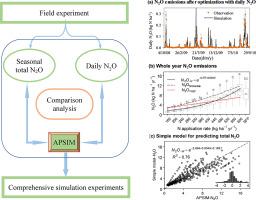Agricultural Systems ( IF 6.1 ) Pub Date : 2021-09-22 , DOI: 10.1016/j.agsy.2021.103277 Jianzheng Li 1 , Ligang Wang 2 , Zhongkui Luo 3 , Enli Wang 4 , Guocheng Wang 5 , Han Zhou 1 , Hu Li 2 , Shiwei Xu 1

|
CONTEXT
Modelling approaches have already been used to quantitatively assess the trade-offs between crop yield and N2O emissions as impacted by management practices. However, the model's performance in terms of predicting N2O emissions was mainly assessed against total emissions per growing season or year, which may reduce accuracy in modelling due to the uncertainties in total emissions estimated using the manual (static) chamber method.
OBJECTIVE
Here, a comparison between optimizations for Agricultural Production Systems sIMulator (APSIM) with total N2O emissions and daily N2O emissions was conducted. We further used the validated model to develop simple surrogate models for estimating total N2O emissions in different years and target potential opportunities to reduce N2O emissions while still maintaining the grain yield under long-term climatic conditions.
METHODS
Five parameters relating to denitrification and nitrification were optimized using differential evolution algorithm for global optimization based on two-year field experimental data at Huantai site in North China Plain, and comprehensive simulation experiments were further conducted under long-term climate variability in an irrigated wheat–maize rotation system. The method of Levenberg-Marquardt was implemented to fit simple surrogate models for estimating total N2O emissions in different years, and Analysis of Variance was used for model comparison.
RESULTS AND CONCLUSIONS
APSIM model optimized with daily N2O emissions could better simulate soil N2O and nitrate dynamics than that optimized with total N2O emissions. We obtained the posterior distributions of five key parameters to which N2O emissions are sensitive, and demonstrated that original model using default parameters could underestimate the rate of nitrification and denitrification and the subsequent N2O emissions. Total N2O emissions increased exponentially with nitrogen application rate and mean temperature, and IPCC (1% emission factor) could underestimate whole-year N2O emissions when N rate was higher than the optimized nitrogen rate for crop production. We also found that there was potential to optimize nitrogen fertiliser rate to reduce N2O emissions while still maintaining crop yield in the irrigated wheat–maize rotation system.
SIGNIFICANCE
This study demonstrated the necessity of optimization with daily N2O emissions in improving model accuracy, and the posterior distributions of five parameters relating to N2O emissions offered reference range for future model improvement and applications.
中文翻译:

在 APSIM 建模的小麦-玉米轮作系统中减少 N2O 排放,同时保持产量
语境
建模方法已被用于定量评估受管理实践影响的作物产量和 N 2 O 排放之间的权衡。然而,该模型在预测 N 2 O 排放方面的性能主要是根据每个生长季节或年份的总排放量来评估的,由于使用手动(静态)室方法估计的总排放量存在不确定性,这可能会降低建模的准确性。
客观的
在这里,对农业生产系统模拟器 (APSIM) 的优化与 N 2 O总排放量和每日 N 2 O 排放量进行了比较。我们进一步使用经过验证的模型开发了简单的替代模型,用于估算不同年份的N 2 O总排放量,并瞄准在长期气候条件下仍保持粮食产量的同时减少 N 2 O 排放量的潜在机会。
方法
以华北平原桓台样地两年田间试验数据为基础,利用差分进化算法对反硝化和硝化相关5个参数进行全局优化,并在长期气候变化条件下进一步对灌溉小麦进行综合模拟试验——玉米轮作制度。应用Levenberg-Marquardt 方法拟合简单的替代模型来估算不同年份的N 2 O 排放总量,并使用方差分析进行模型比较。
结果和结论
APSIM模型每日Ñ优化2个O排放能更好地模拟土壤氮素2 O和硝酸盐动力学比具有总共N个优化的2个O排放。我们获得了 N 2 O 排放敏感的五个关键参数的后验分布,并证明使用默认参数的原始模型可能低估硝化和反硝化的速率以及随后的 N 2 O 排放。N 2 O 排放总量随施氮量和平均温度呈指数增长,IPCC(1% 排放因子)可能低估全年 N 2当氮含量高于作物生产的优化氮含量时,O 排放。我们还发现,在灌溉小麦 - 玉米轮作系统中,有潜力优化氮肥施用量以减少 N 2 O 排放,同时仍保持作物产量。
意义
这项研究表明优化的必要性与每日Ñ 2个O排放在改进模型的准确性,和5个参数有关到N的后验分布2提供参考范围未来模型改进和应用O排放。











































 京公网安备 11010802027423号
京公网安备 11010802027423号